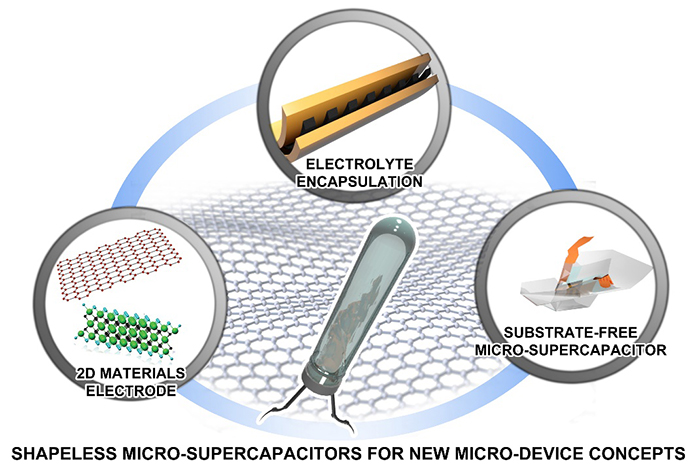A research work done by Prof. WU Zhong-Shuai and Prof. FU Qiang from Dalian Institute of Chemical Physics (DICP) of the Chinese Academy of Sciences (CAS) has successfully demonstrated new-concept planar micro-supercapacitors by encapsulating high capacitance electrodes within a robust hydrogel matrix which renders it essentially shapeless, which has been published with the title of “Substrate-Free and Shapeless Planar Micro-Supercapacitors” in the journal Adv. Funct. Mater.
Electrochemical energy storage devices (EESDs) are presently at the frontier of clean energy research. However, they have not been able to keep up with the rapid progress in energy generation and consumption devices due to constraints on form factor of the EESDs. Such problems hinder the integration of EESDs with electronics, thus preventing the realization of truly independent, shape-versatile machines. The root cause of this problem is apparently the mechanical incompatible adhesion of different electrodes with electrolyte and the substrate.
Moreover, the substrate (typically polymers like poly-ethylene terephthalate, glass, silicon), although being an inactive component contribute most to the total weight and volume of the entire device, thus overshadowing the high performance of two-dimensional active materials and reducing the total energy output of EESDs.
Therefore, it is necessary to innovate new architectures for EESDs that will allow the removal of inactive components and maintain high capacitance of devices with ultrathin geometry; thus, promoting superior integration.

Substrate-free and shapeless micro-supercapacitors for next-generation electronics (Image by DAS Pratteek)
To this end, our scientists WU Zhong-Shuai et. al at DICP, reported a prototype planar and shapeless micro-supercapacitor (SMSC) by encapsulating ultrathin MXene-based electrodes (5 mm) inside thin film hydrogel electrolyte (37 mm) to realize ultraflexible features along with high capacitance output from a single device. The total areal capacitance of 40.8 mF cm-2 is among the highest reported value for MXene-based supercapacitors.
Additionally, the flexibility is unparalleled since the device can be bend, folded, spiralled, crumpled and passed through fluid channels, thanks to its ultrathin and shapeless nature. Furthermore, this technology is easily scalable not only to other electrode fabrication methods, but also to different active materials as well.
This has been demonstrated by preparing 9 series-connected SMSCs with screen-printed graphene electrodes delivering a 7.2 V while crumpling them from 0.11 to 0.01 cm3 in an extremely deformed state. Such devices hold promises for finally closing the gap between electronics and EESDs for creating independently powered, next-generation nanomachines for a variety of unthinkable applications.
This work was supported by National Natural Science Foundation of China, National Key R&D Program of China, CAS-TWAS President’s Fellowship, etc. (Text by DAS Pratteek, HOU Xiaocheng)